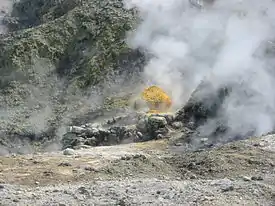Solfatara (volcano)
Solfatara (Italian: Solfatara di Pozzuoli) is a shallow volcanic crater at Pozzuoli, near Naples, part of the Phlegraean Fields (Italian: Campi Flegrei) volcanic area. It is a dormant volcano, which still emits jets of steam with sulfurous fumes. The name comes from the Latin, Sulpha terra, "land of sulfur", or "sulfur earth". It was formed around 4000 years ago and last erupted in 1198 with what was probably a phreatic eruption – an explosive steam-driven eruption caused when groundwater interacts with magma. The crater floor was a popular tourist attraction until 2017, as it has many fumaroles and mud pools. The area is well known for its bradyseism. The vapours had been used for medical purposes since Roman times.
| Solfatara | |
|---|---|
 Sulfur at the Solfatara crater | |
| Highest point | |
| Elevation | 458 m (1,503 ft)[1] |
| Coordinates | 40.827°N 14.139°E |
| Geography | |
| Location | Italy |
| Geology | |
| Age of rock | 40,000 years |
| Mountain type | Crater of Campi Flegrei |
| Volcanic arc/belt | Campanian volcanic arc |
| Last eruption | 1198[1] |
This volcano is where the thermoacidophilic archaeon Sulfolobus solfataricus was first isolated. The archaeon is named for the volcano, as most species of the genus Sulfolobus are named for the area where they are first isolated.
Notable events
Saint Proculus (the patron saint of Pozzuoli) and Saint Januarius (the patron saint of Naples) were beheaded at Solfatara in 305.
In 2017, three people—an 11-year-old boy and his parents—died, when they fell into a chasm. Initial rumors that claimed that the boy had entered an off-limits area of the crater[2] were declared false by an eyewitness who had watched the scene unfold from her balcony.[3] According to the eyewitness, the family were on the official walking path, when the 11-year-old slipped into the unsecured chasm. His parents died in an attempt to save him. The only survivor was the boy's 7-year-old brother.
Gallery
 Panoramic view of the crater towards the southeast
Panoramic view of the crater towards the southeast Close-up view of a mud pool
Close-up view of a mud pool Medium size fumarole in Solfatara
Medium size fumarole in Solfatara.jpg.webp) Biggest fumarole in Solfatara
Biggest fumarole in Solfatara
See also
References
- Kilburn, Chris; McGuire, Bill (2001). Italian Volcanoes (Classic Geology in Europe 1). Terra Publishing. pp. 174 pp. ISBN 1-903544-04-1.
- "Campi Flegrei". Global Volcanism Program. Smithsonian Institution. Retrieved 2008-09-20.
- "Boy and parents die in volcanic crater". BBC News. 2017-09-12. Retrieved 2017-12-18.
- "Morti nella solfatara,testimone: la voragine non era stata segnalata - Tgcom24". Tgcom24. Retrieved 2017-12-18.